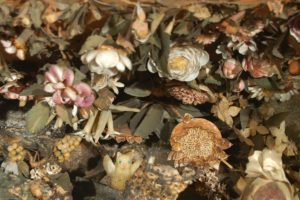New Research on the Tudor Place Tableau
By GRANT QUERTERMOUS, Curator, Tudor Place Historic House & Garden
Among the most fascinating objects found in the collection of Tudor Place in Washington, DC, is an 18th-century wax and shellwork tableau handcrafted by Samuel Fraunces as a gift for Martha Washington. In 1783, the year in which he likely produced the scene, Fraunces hosted at his New York City tavern George Washington’s farewell address to his officers.
Depicting a scene from Homer’s Iliad, the tableau features elaborately costumed wax figures of the Trojan warrior Hector, his wife Andromache, their infant son Astyanax, and a nursemaid surrounded by animals against a backdrop festooned with flowers and garlands made of shells, coral, and colored paper. A gazebo-like structure with painted paper roof and parquet floor completes the scene, which is enclosed in a pine box with glazing on three sides.
Acquired at the 1802 sale of Martha Washington’s estate by her granddaughter Martha Custis Peter, the tableau has lived at Tudor Place for over two centuries. In January 1954, Armistead Peter 3rd, the last owner of Tudor Place, undertook an amateur “restoration” of the family heirloom. The contents of the tableau had come loose, and some figures were damaged. Peter repaired the wax figures but was unable to fit all the animals back into the tableau. Unfortunately, no photos survive to document the original orientation of the figures prior to the 1954 repairs; fortunately, Peter preserved the unaccommodated elements in an adjacent cabinet.
The tableau was displayed at Tudor Place until 2010 when the current conservation project began. As reported in the Spring 2012 issue of the Trust’s Newsletter, interesting discoveries quickly followed. X-rays of the figures revealed the straight pins used in their original construction, and conservators recovered fragments of 18th-century wallpaper from the top of the case.
Subsequent conservation produced additional discoveries about the tableau and the materials used in its construction. Analysis of the shells by experts at the Smithsonian’s National Museum of Natural History suggested that all were native to the Caribbean rather than New York City, where Fraunces likely constructed the tableau. The shells were originally covered in a mineralized copper-alloy glitter to create a metallic luster. This glitter had dulled, which gave the shells a dirty appearance that required very careful and limited cleaning.
The wax figures present significant conservation challenges. Their costumes are made of 18th-century textiles, including silk and satin, and many are accented with metallic lace embellishments. The costumes are also affixed to each figure with straight pins, making it impossible to remove the textiles for conservation without risking further damage to both the costumes and figures.
This project is ongoing due to the volume and variety of materials that must be cleaned and stabilized and the funding required for the project. Once complete, the tableau will again be placed on display at Tudor Place to allow visitors to enjoy an extraordinary object that celebrates Fraunces’ esteem for Martha Washington and has been associated with the Peter family and their home for over two centuries.
For more information on Tudor Place and its collection, visit www.tudorplace.org.
By GRANT QUERTERMOUS, Curator, Tudor Place Historic House & Garden
Among the most fascinating objects found in the collection of Tudor Place in Washington, DC, is an 18th-century wax and shellwork tableau handcrafted by Samuel Fraunces as a gift for Martha Washington. In 1783, the year in which he likely produced the scene, Fraunces hosted at his New York City tavern George Washington’s farewell address to his officers.
Depicting a scene from Homer’s Iliad, the tableau features elaborately costumed wax figures of the Trojan warrior Hector, his wife Andromache, their infant son Astyanax, and a nursemaid surrounded by animals against a backdrop festooned with flowers and garlands made of shells, coral, and colored paper. A gazebo-like structure with painted paper roof and parquet floor completes the scene, which is enclosed in a pine box with glazing on three sides.
Acquired at the 1802 sale of Martha Washington’s estate by her granddaughter Martha Custis Peter, the tableau has lived at Tudor Place for over two centuries. In January 1954, Armistead Peter 3rd, the last owner of Tudor Place, undertook an amateur “restoration” of the family heirloom. The contents of the tableau had come loose, and some figures were damaged. Peter repaired the wax figures but was unable to fit all the animals back into the tableau. Unfortunately, no photos survive to document the original orientation of the figures prior to the 1954 repairs; fortunately, Peter preserved the unaccommodated elements in an adjacent cabinet.
The tableau was displayed at Tudor Place until 2010 when the current conservation project began. As reported in the Spring 2012 issue of the Trust’s Newsletter, interesting discoveries quickly followed. X-rays of the figures revealed the straight pins used in their original construction, and conservators recovered fragments of 18th-century wallpaper from the top of the case.
Subsequent conservation produced additional discoveries about the tableau and the materials used in its construction. Analysis of the shells by experts at the Smithsonian’s National Museum of Natural History suggested that all were native to the Caribbean rather than New York City, where Fraunces likely constructed the tableau. The shells were originally covered in a mineralized copper-alloy glitter to create a metallic luster. This glitter had dulled, which gave the shells a dirty appearance that required very careful and limited cleaning.
The wax figures present significant conservation challenges. Their costumes are made of 18th-century textiles, including silk and satin, and many are accented with metallic lace embellishments. The costumes are also affixed to each figure with straight pins, making it impossible to remove the textiles for conservation without risking further damage to both the costumes and figures.
This project is ongoing due to the volume and variety of materials that must be cleaned and stabilized and the funding required for the project. Once complete, the tableau will again be placed on display at Tudor Place to allow visitors to enjoy an extraordinary object that celebrates Fraunces’ esteem for Martha Washington and has been associated with the Peter family and their home for over two centuries.
For more information on Tudor Place and its collection, visit www.tudorplace.org.



